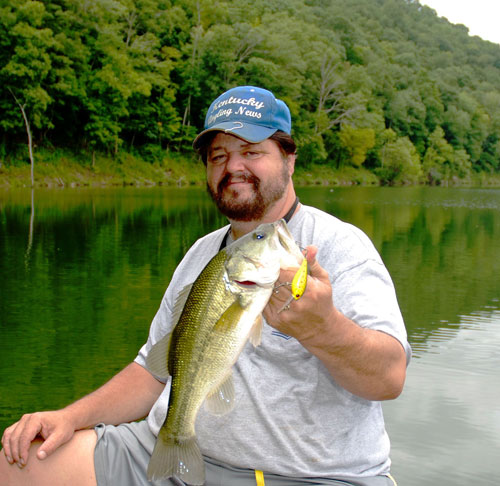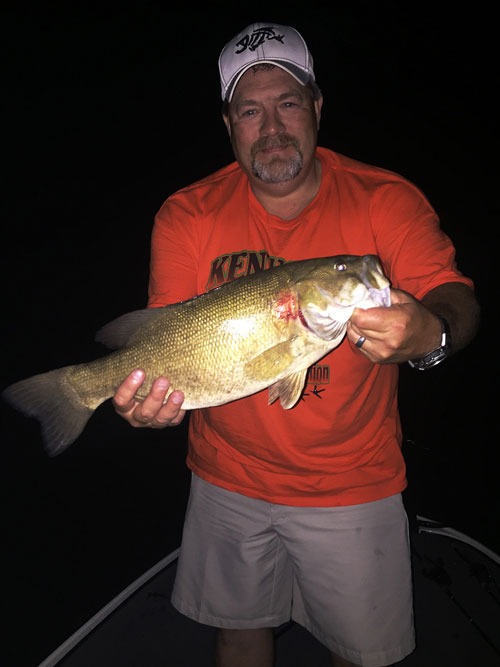
By Chris Erwin
As we head into the hottest part of the summer, many anglers will lay down their rods and wait for cooler temperatures.

However, for those brave people, trying to keep hope alive let me just say hope does exist. At least for the bass, crappie, white bass, blue gill, once the water gets this hot.
I don’t suggest catching a musky. Usually, they will be coming out of deeper cooler water, and it’s almost impossible to get them back in the water fast enough to keep from killing them.
If you happen to catch one in shallow water, your chances are good but a deep-water fish taken from trolling or extra deep diving lures tend to catch fish in cooler water, which makes it very hard to get a good release on a big fish.
Bass and White Bass are usually feeding on shad this time of the year. This makes catching bass possible on our eastern lakes by fishing what I call the “summer milk run.”
So what is the milk run? And how do you do it?
The answers are not that hard. I have found that summer bass tends to suspend in the river trees. Now anyone who has fished Cave Run or other eastern lakes knows that they are trees everywhere so where do you try?
Let’s break this down a bit. What I have found is that the bass aren’t always where you might think. Jumping around sometimes pays big benefits, but for the most part, they are predictable.
Most people head for the channel trees and think that’s where they have to be. Sometimes you will find them there, especially during the low-light periods early in the morning and late in the evenings.
However, I have found that bass in the heat of the summer like to suspend in the trees that are on the first or second break from the shady side of the bank. These trees will be standing in deep water with only the tops’ showing. They are usually 10 to 20 feet from the bank and run along the channel edge.
During this time of the year, the water is usually clear, and we need to make it to about 12 to 15 feet deep. So this will eliminate many lures.
Before I tell you what lures I use, just let me say the bottom draggers are going to catch some fish during this period, but I find it to be slow.
I usually go the way of the crankbait. Why? For one, the action is faster. No. 2, when fish are suspended I think you have better success if they are looking up to find your lure instead of trying to draw a fish to the bottom.
A whacky-style weightless worm may also be a good choice. Again, this method may be too slow if you’re looking for active fish; however, once you locate them it may be a productive choice.
Most of these fish will be holding at about 15 to 20 feet but in clear water pulling a fish to 12 feet is very possible.

Here are a few suggestions that will help trigger strikes while fishing this method. No 1: Use lighter line, the musky are not going to be hitting during this heat wave, so use a lighter line. I usually go down to 12-pound test. This will also let your crankbait run deeper.
No 2: You may be casting the bank to fish this method, but remember the fish are not on the bank, so you must focus on the areas where the fish will be. That’s in the trees!
What does this mean? As you crank your bait down, and you start approaching the trees, slow down the lure, pause it, twitch it, burn it.
The point is you are looking for what will trigger a strike. If you have faith that the fish are there, and they are, you just need to find what will trigger them to strike.
No. 3: Bait color. It’s no secret I use white, bone, or shad colors. Why? Because it works! In dirty water I might make a different choice but in clear water stick to what works.
No 4: You need to take your time. Throw each tree more than once. Try to envision the lure coming up to the tree. Stop it and then twitch it as you crank it on in. Slow your retrieve again as the lure starts to climb to the surface. I get a lot of late strikes doing this.
The bass tends to position themselves on the shade side of the tree or under leaning trees. It’s important to file all this away in your mind as you look for a way to invoke a strike. Once you find the keys to this pattern you can, at times, catch a lot of fish during what many feel is the slowest time of the summer.
I hope this will inspire a few of you to hang in there and learn how to be productive even when the conditions are tough.
The Summer Milk Run is a term I picked up while fishing tournaments. During these hot periods of summer once you find the pattern that works it will usually hold up all summer until the water starts to cool.
Chris Erwin is the author of Camping Kentucky, founder and publisher of Kentucky Angling News an on-line magazine available at www.kentuckyangling.com/magazine Chris can be reached by email chris@ashlandbeacon.com


Be the first to comment